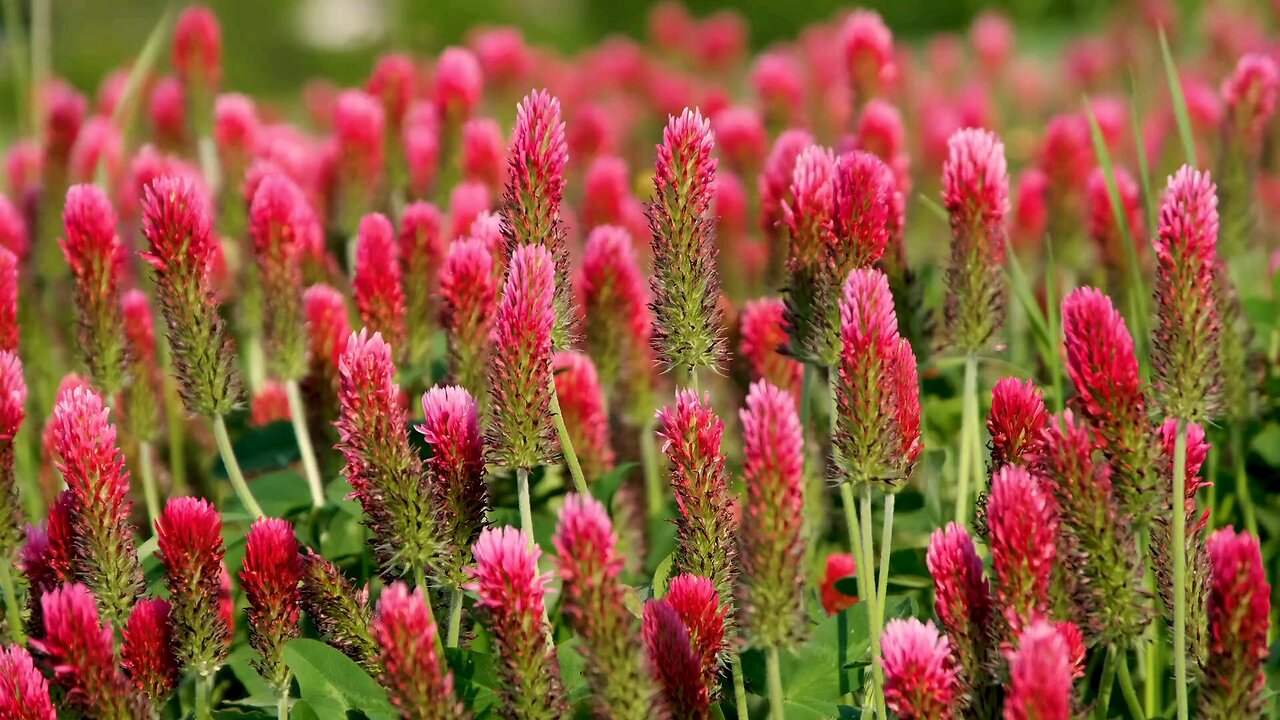Premium Only Content

"Red Clover (Trifolium pratense): Vibrant Blooms and Benefits"
Red clover (Trifolium pratense) is a perennial herbaceous plant belonging to the legume family (Fabaceae). It is native to Europe, Western Asia, and northwest Africa but has been widely naturalized in many other regions, including North America.
### Characteristics
- **Appearance**: Red clover has a characteristic pinkish-red flower head composed of numerous small, tubular florets. Its leaves are trifoliate, meaning they have three leaflets, often with a pale, crescent-shaped mark.
- **Growth**: It typically grows to a height of 20-80 cm and thrives in a variety of soils, especially well-drained, loamy soils. Red clover is often found in fields, meadows, and along roadsides.
- **Lifecycle**: It is a short-lived perennial, often surviving for 2-3 years.
### Uses
- **Agricultural**:
- **Forage Crop**: Widely used as livestock fodder due to its high protein content and palatability.
- **Cover Crop**: Helps in soil improvement and management, as it fixes nitrogen, improving soil fertility.
- **Crop Rotation**: Used in crop rotation systems to reduce soil erosion and improve soil structure.
- **Medicinal**: Red clover is known for its phytoestrogens, which are compounds that mimic estrogen in the body. It is used in traditional medicine for:
- **Menopausal Symptoms**: Alleviating hot flashes and other menopausal symptoms.
- **Skin Health**: Treating skin conditions like eczema and psoriasis.
- **Cardiovascular Health**: Supporting heart health by improving circulation and reducing blood pressure.
- **Culinary**: Though less common, the flowers and leaves can be used in salads or as a garnish. They are also sometimes used to make herbal teas.
### Environmental Benefits
- **Biodiversity**: Red clover provides a habitat and food source for various pollinators, including bees and butterflies.
- **Soil Health**: Enhances soil structure and fertility through nitrogen fixation and organic matter addition.
### Cultivation
- **Planting**: It is usually sown in early spring or late summer. It requires adequate sunlight and moderate watering.
- **Maintenance**: Minimal maintenance is required once established, but periodic mowing can encourage denser growth.
### Challenges
- **Pests and Diseases**: Susceptible to root rot, powdery mildew, and various pests like aphids.
- **Invasiveness**: While beneficial, it can sometimes become invasive in non-native regions, outcompeting local flora.
Overall, red clover is a versatile and valuable plant in agriculture, medicine, and environmental management.
-
 LIVE
LIVE
Akademiks
1 hour agoDiddy Trial Day 23: Kanye West Shows up to Support DIDDY n CONFRONT JANE DOE Day 5/30
2,175 watching -
 LIVE
LIVE
Simply Bitcoin
2 hours ago $1.28 earnedBillionaire: Hundreds Of TRILLIONS Of Dollars Coming For Bitcoin | EP 1265
283 watching -
 2:06:13
2:06:13
Tim Pool
3 hours agoCatholics Are The SUPERIOR Christians, DEBATE | The Culture War with Tim Pool
136K235 -
 LIVE
LIVE
The Charlie Kirk Show
1 hour agoAmerica and the Iran War + AMA | Hammer | 6.13.25
4,455 watching -
 LIVE
LIVE
Side Scrollers Podcast
2 hours agoThe BIGGEST FLOP of 2025 | Side Scrollers Live
296 watching -
 LIVE
LIVE
LFA TV
18 hours agoFORCE PEACE IN THE MIDDLE EAST! | LIVE FROM AMERICA 6.13.25 11AM
1,766 watching -
 LIVE
LIVE
The Big Mig™
1 hour agoGlobal Finance Forum From Bullion To Borders We Cover It All
45 watching -
 LIVE
LIVE
Rebel News
1 hour agoIsrael strikes nuclear sites and Iran retaliates, Rebel News fights for G7 access | Rebel Roundup
502 watching -
 1:30:03
1:30:03
Steven Crowder
4 hours agoIsrael Strikes Iran: Does this Really Mean War for America & How Does Trump Respond
247K205 -
 LIVE
LIVE
Viss
2 hours ago🔴LIVE - The PUBG Tactics You Need To Win Battle Royales Consistently!
118 watching